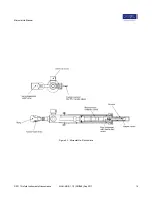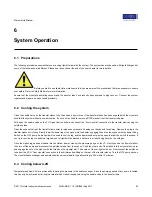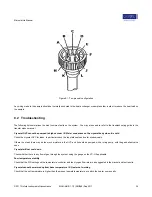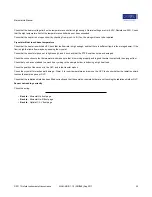
Microstat He Manual
6.8
Changing samples
Warm the cryostat to room temperature, as described above. The sample is mounted on the heat exchanger within the OVC.
For the MicrostatHe cryostats, the OVC and part of the radiation shield have to be removed in order to change samples. For the Optistat
it is only necessary to remove the OVC. The removal of the OVC and radiation shield is described in the following chapter.
When the sample has been replaced, re-assemble the cryostat and evacuate the OVC. Proceed to cool the system down as described
previously.
6.8.1
Sample holders
Various sample holders are available for use with the cryostat, including:
• A solid flat holder covering the entire clear aperture. Several small samples may be mounted on this sample holder, so that they
can all be measured without having to warm up to change samples.
• A sample holder is designed for transmission measurements, which has has a 12.5mm diameter aperture and includes a sample
retaining clamp.
6.8.2
Adjusting the sample position
The sample holder can be adjusted to position the sample as close as possible to the inside of the OVC window. This adjustment has
to be made before the radiation shield and OVC are fitted. Take care to ensure that neither the sample nor the sample holder touch the
radiation shield, OVC, or window.
To adjust the position of the sample holder the screw should be loosened. This will allow you to slide the holder up and down. The sample
holder is located in a groove in the cold finger, which prevents it from being rotated during adjustment.
6.9
Operating with liquid Nitrogen
The cryostat can also be operated with liquid Nitrogen instead of Helium. The basic operating procedure is the same, but there are a few
differences:
1. Ensure that the flow gauge calibrated for
air
is used on the VCU.
2. The viscosity of liquid Nitrogen is greater than that of Helium, so the flow rate through the cryostat is lower. This increases the
cooldown time.
3. If you pump the liquid Nitrogen to a pressure below 150mbar it may freeze and block the cryostat. A GF4 pump is unlikely to reduce
the pressure sufficiently, but a rotary pump could.
4. It is more difficult to control the temperature of the sample, and the stability specification is typically increased to ±0.2K. It may be
more difficult to control the temperature below 90K because liquid collects in the heat exchanger and boils intermittently.
5. Liquid Nitrogen is not cold enough to cryopump air effectively, so it is more difficult to maintain a good vacuum in the OVC and
transfer siphon. It may be necessary to pump the OVC and transfer siphon continuously.
6. It is best to use the minimum flow possible to achieve good stability at low temperatures (especially below 90K). If the temperature
remains stable for a short time then suddenly becomes unstable, try reducing the flow. Adjust the flow rate slowly so that any liquid
collected in the heat exchanger has time to boil away.
7. The optimum flow rate for base temperature should be suitable for the whole temperature range. The flow rate can be increased to
cool down more quickly, but should be reduced again as base temperature is approached to prevent the cryostat from filling with
liquid.
© 2017 Oxford Instruments Nanoscience
MAN-MHE-1.1.0 (28ff3d8) Sep 2017
25











































